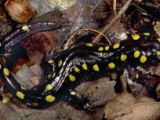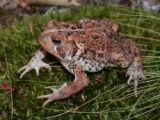Boston University (BU) Scientists at Boston University studied the defenses used by three amphibian species: spotted salamander (Ambystoma maculatum)(above), wood frog (Rana sylvatica)(bellow), and American toad (Bufo americanus) (center) to protect their eggs against deadly water molds found in vernal pools of Northeast US. "Certain water molds cause substantial mortality for aquatic eggs of a wide range of fish and amphibian species throughout the world," said Dr. Ivan Gomez-Mestre.
"The observations and results of this study demonstrate that there are both parental and embryonic-stage traits that defend egg clusters against water mold infections in three species of amphibians found in the Northeast."
Vernal pools forms because of the rising water table due to autumn rainfall and the melting and runoff of winter and spring snow and rain. Many vernal pools contain water only during spring and early summer and usually - by late summer - are completely dry. Nine pools were surveyed twice every week during the spring and early summer.
The amphibian clutches were flagged and monitored until they hatched except for the few collected for laboratory experiments.
Mold infection was present in all the pools.
Eight of the nine had high infection rates, of 66 - 86 %, while the largest pond with the thickest tree canopy and the lowest temperature had only 16 % infection rate. "We visually estimated the degree of mold infection within each clutch and considered clutches to be infected when mold had grown over 5 percent or more of the clutch and increased over subsequent observations," said Justin Touchon, a graduate student.
All amphibian species had behaviors that helped them protect from or survive infections by water molds. Salamander's eggs are covered in a protective jelly layer that impedes mold from reaching the embryos.
Frog females secrete less jelly, but wood frogs mate early while ponds are still cold and mold growth is slow. As the toads mate later and possess a thin jelly coat in their eggs, they presented the highest rate of infection. Despite this, eggs of all three species are able of rushing the hatching if mold reaches them and the toad was the most rapid in doing this. Toad embryos shortened their embryonic stage with 36 %, hatching before they could even move, thus a chemical background must stay behind this. "This is quite a dramatic change. If you compared it to humans, this would be like a six months premature baby," said Dr. Karen Warkentin.
The salamander exhibited early hatching only when its jelly coat was removed, exposing the eggs to the mold.
Despite the jelly coat, in upstate New York, salamanders suffer high mortality from water mold infections. "We don't yet know if the mold is different in Boston, or the eggs," said Gomez-Mestre.
Despite consuming toad hatchling, frog tadpoles can protect the toad eggs by eating mold off infected toad clutches, this way increasing their survival. "These defenses appear to reduce the overall impact of water mold, so that massive egg mortality is normally associated with a several stressors. Furthermore, interactions with other species may further reduce mortality rates of infected clutches," explained Gomez-Mestre.
"The impact of water molds on a given species therefore depends not only on the effectiveness of the its own defenses, but also on the community composition and the ecological interactions at work in the pool."
The study is especially important because - currently - many amphibian populations are under threat due to contamination and also to the spread of another lethal fungus, Batracochytrium, in face of which adult amphibians seem defenseless.

 14 DAY TRIAL //
14 DAY TRIAL // 

